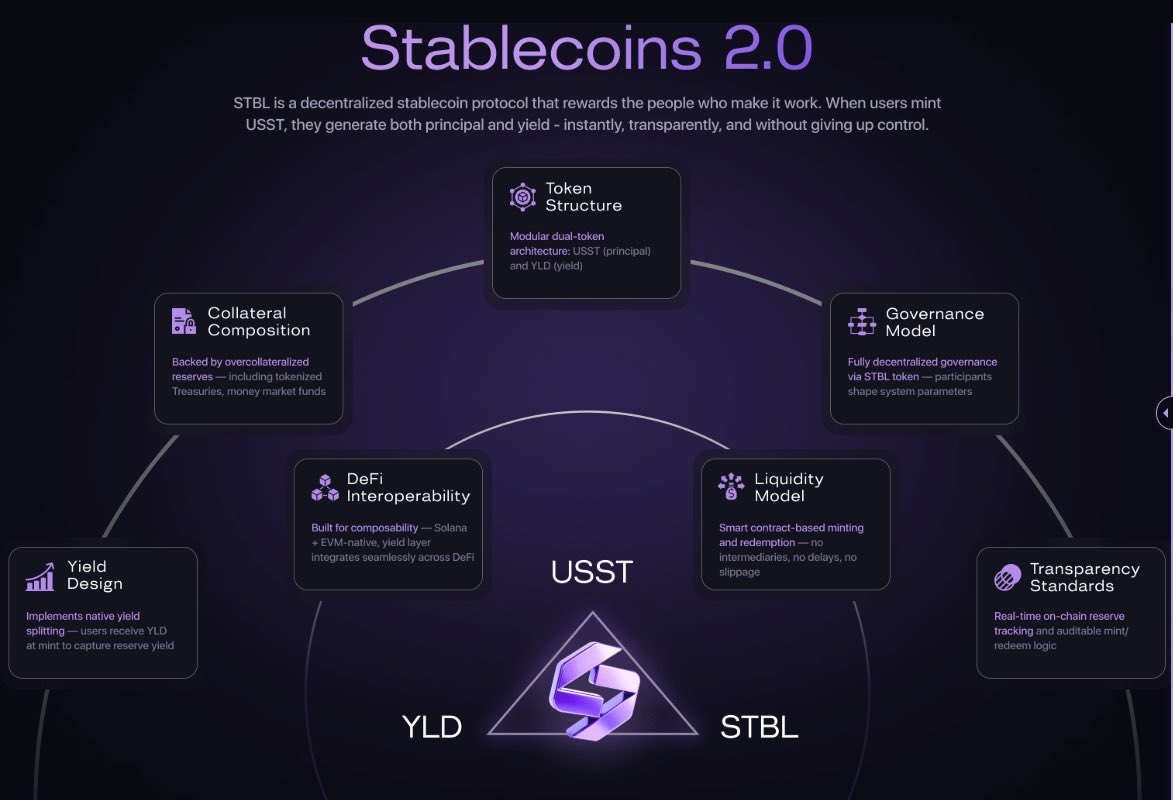How STBL’s Yield-Separating Stablecoin Model is Changing RWA-Backed DeFi

Traditional stablecoins have long forced DeFi users to choose between liquidity and yield. STBL, currently trading at $0.0980 ( and 0.0246% in the last 24 hours), is rewriting this paradigm by introducing a three-token system that leverages tokenized real-world assets (RWAs) and separates principal from yield at the protocol level. This architecture not only optimizes capital efficiency but also creates composable building blocks for next-generation DeFi products.
STBL’s Three-Token Model: Principal, Yield, and Governance Decoupled
At the heart of STBL’s innovation is a clear separation of functions across three tokens:
- USST: An overcollateralized stablecoin pegged to the US dollar and backed by tokenized RWAs (such as U. S. Treasury bonds or on-chain money market funds).
- YLD: A non-fungible token (NFT) that accrues all yield generated by the underlying collateral used to mint USST.
- STBL: The governance and fee token, enabling holders to vote on protocol upgrades, collateral types, and risk parameters.
This model enables users to mint USST by depositing approved yield-bearing assets. The deposited asset’s principal value becomes USST, instantly liquid and usable across DeFi. Simultaneously, the right to future yield is spun out into a YLD NFT, effectively unbundling utility from passive income.
The Mechanics of Yield Separation: How It Works
The process begins when a user deposits an approved RWA-backed asset, such as Ondo’s USDY or BlackRock’s BUIDL, into the STBL protocol. Here’s what happens under the hood:
- Minting: The user receives USST stablecoins equivalent to the principal value of their deposit.
- Yield Rights: Simultaneously, they are issued a YLD NFT that accrues all future yield generated by that specific deposit.
- Governance Oversight: Protocol parameters, including collateral eligibility and risk controls, are managed via votes using STBL tokens.
This structure allows users to deploy their USST in trading, lending, or liquidity pools without sacrificing any of the underlying asset’s passive income potential, which instead flows directly to holders of YLD NFTs.
The Implications for RWA-Backed DeFi Innovation
The significance of STBL’s approach becomes clear when considering how it bridges traditional finance with DeFi primitives. By using tokenized government securities or money market funds as collateral, and keeping all reserves transparently on-chain, the protocol delivers verifiable backing for every minted USST.
This design eliminates reliance on inflationary rewards or leveraged farming strategies typical in earlier generations of stablecoins. Instead, it offers sustainable on-chain yields sourced directly from real-world financial instruments, a concept sometimes called “Stablecoin 2.0. ” For investors seeking composability and risk minimization in DeFi yields, this is a major leap forward.
For more technical details on how RWA-backed stablecoins like STBL are redefining DeFi yields and compliance frameworks, see this deep dive.
STBL (STBL) Price Prediction 2026-2031
Scenario analysis based on RWA-backed stablecoin adoption, DeFi trends, and regulatory developments
| Year | Minimum Price (Bearish) | Average Price (Base Case) | Maximum Price (Bullish) | % Change (Avg YoY) | Key Scenario Insights |
|---|---|---|---|---|---|
| 2026 | $0.085 | $0.13 | $0.19 | +32.7% | Post-launch volatility; initial RWA adoption accelerates, but macro uncertainty remains |
| 2027 | $0.11 | $0.18 | $0.28 | +38.5% | Broader DeFi integration; regulatory frameworks clarify RWA usage, increasing institutional interest |
| 2028 | $0.15 | $0.25 | $0.39 | +38.9% | Mainstream RWA-backed DeFi adoption; STBL ecosystem matures, more assets onboarded |
| 2029 | $0.19 | $0.32 | $0.51 | +28.0% | Yield-separating model gains traction; increased competition but STBL retains first-mover advantage |
| 2030 | $0.24 | $0.39 | $0.67 | +21.9% | RWA stablecoins become DeFi standard; cross-chain integrations expand user base |
| 2031 | $0.30 | $0.47 | $0.85 | +20.5% | STBL governance token achieves blue-chip status in RWA DeFi, but faces maturing market dynamics |
Price Prediction Summary
STBL is positioned to benefit significantly from the growing adoption of RWA-backed stablecoins and the unique yield-separating model. Price appreciation is expected to be steady, with notable upside if mainstream DeFi and TradFi adoption accelerates. However, volatility and regulatory risks remain, particularly in the early years of expansion.
Key Factors Affecting STBL Price
- Adoption rate of RWA-backed DeFi protocols and stablecoins
- Regulatory clarity and global acceptance of tokenized securities
- Integration with major DeFi and TradFi platforms
- Competition from other RWA or yield-separating stablecoin protocols
- Protocol upgrades, governance decisions, and risk management
- Macro economic factors (interest rates, global liquidity)
- Security of on-chain RWA tokenization mechanisms
Disclaimer: Cryptocurrency price predictions are speculative and based on current market analysis.
Actual prices may vary significantly due to market volatility, regulatory changes, and other factors.
Always do your own research before making investment decisions.
STBL’s separation of yield and principal is more than a technical novelty, it unlocks new composability for DeFi strategies. For example, a risk-averse user can hold USST to maintain dollar exposure and liquidity, while a yield-seeking participant can purchase YLD NFTs on secondary markets to gain pure exposure to passive income streams. This creates an organic marketplace for yield, untethered from the constraints of principal redemption or forced lockups.

Because YLD NFTs are transferable, sophisticated users can package them into structured products or use them as collateral elsewhere in DeFi. This is a significant step toward true financialization of on-chain yield rights, akin to how traditional finance separates coupon payments from bond principals (strips) but with on-chain transparency and programmability.
Risk Management, Transparency, and Protocol Sustainability
Unlike many algorithmic stablecoins that rely on endogenous collateral or unsustainable emissions, STBL’s architecture is inherently risk-conscious. All collateral remains on-chain and auditable at any time. The protocol’s governance token (STBL), currently priced at $0.0980, gives the community direct oversight over risk parameters such as collateral eligibility, loan-to-value ratios, and emergency shutdown mechanisms.
This robust governance framework reduces systemic risks while aligning incentives between protocol users, liquidity providers, and long-term stakeholders. As a result, STBL avoids the reflexivity traps that have plagued earlier stablecoin models.
Composability: Building Blocks for Next-Gen Passive Income
The modularity of STBL’s three-token system is already inspiring new DeFi primitives:
- Yield Marketplaces: YLD NFTs are being fractionalized and traded in dedicated yield markets.
- Compliant On-Chain Treasuries: DAOs and institutions can hold USST for operational liquidity while selling YLD for immediate cash flow.
- Structured Products: Developers are building vaults that bundle USST with other stables or synthesize fixed-rate lending by combining USST and YLD flows.
This ecosystem effect compounds as more RWA providers onboard their assets as collateral options, further diversifying risk and increasing the protocol’s attractiveness to both retail users and institutional allocators.
The Road Ahead: Scaling RWA-Backed Stablecoins
The success of STBL’s model will depend on continued growth in tokenized RWA markets and integration with the broader DeFi landscape. Key future milestones include onboarding new asset types (such as tokenized commercial paper or investment-grade credit), enhancing cross-chain interoperability for USST liquidity, and expanding secondary markets for YLD NFTs.
If adoption accelerates, as recent price action suggests with STBL up 0.0246% in the last 24 hours, this architecture could become foundational for “Stablecoin 2.0” protocols focused on sustainable yield generation without sacrificing composability or transparency. For those tracking RWA-backed stablecoins and their impact on DeFi yields, this is a sector worth watching closely.
Explore more about how STBL’s architecture is redefining passive income in DeFi here.







